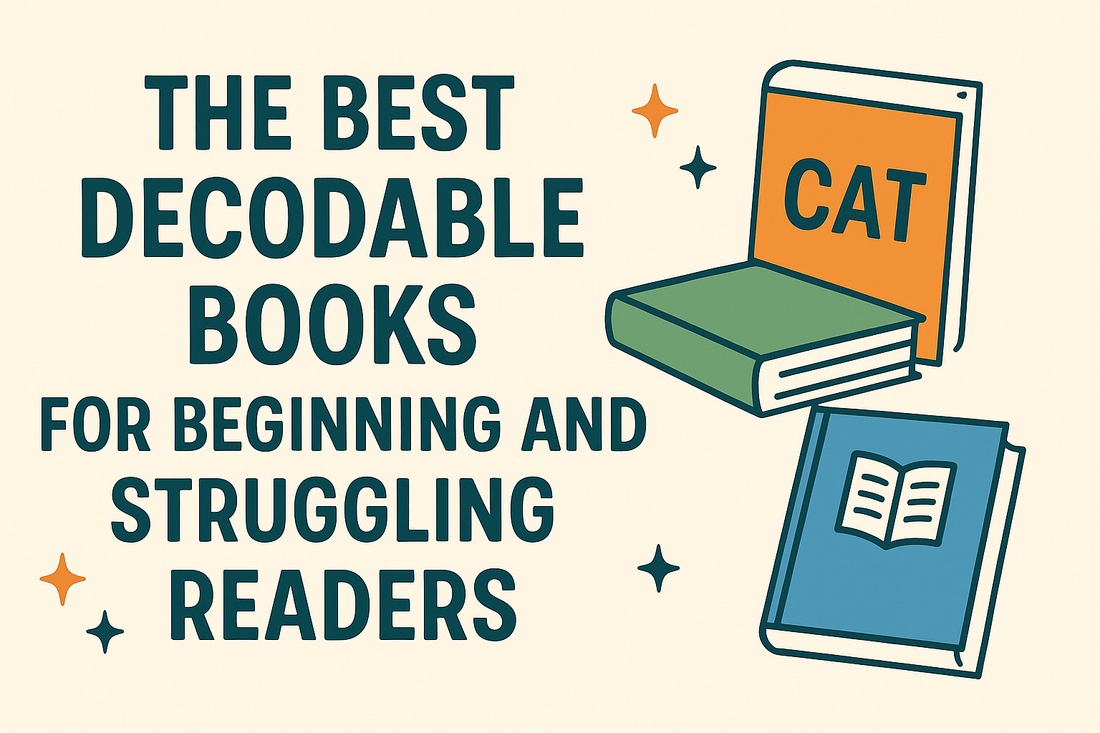Introduction:
If you’re searching for the best decodable books, you’re probably a parent, teacher, or tutor trying to help a child crack the reading code. You may have already tried leveled readers or phonics apps, only to find they didn’t deliver the results you expected. I’ve been there. I’ve taught in classrooms full of struggling readers, and I’ve spent years building and using reading materials that actually work—especially for kids who need a structured, evidence-based approach. In this guide, I’ll walk you through what makes a decodable book truly effective, how they fit into the Science of Reading, and which books I recommend based on years of real-world results. I’ll also explain how we designed our own decodable curriculum based on Orton-Gillingham principles to go beyond the basics and make real, lasting progress possible.
What Are the Best Decodable Books—and Why Do They Work?
The best decodable books aren’t the ones with the flashiest covers or the most marketing buzz. They’re the ones built around structured literacy—using carefully controlled phonics patterns that align with a child’s current reading level. A true decodable reader allows a child to apply the phonics skills they’ve already been taught. That’s key. It means less guessing, more success, and a major confidence boost.
Unlike traditional leveled readers, which often include words students can’t sound out yet, decodable books are designed to build mastery. They follow a systematic sequence—first short vowels and consonants, then digraphs, blends, vowel teams, and multisyllabic words. And they’re not just for students with dyslexia. Structured literacy benefits all learners, especially in the early stages.
How to Spot the Best Decodable Books: 5 Things to Look For
Not all decodable readers are created equal. Here’s how I evaluate quality—and how you can too:
-
Follows a Clear Phonics Scope and Sequence
The best decodable books don’t just “sound decodable”—they’re aligned with what the child has been explicitly taught. That’s why our Orton-Gillingham Curriculum follows a precise order, introducing sounds and patterns only after they’ve been mastered in isolation. -
Repetition Without Boredom
Good decodable texts are repetitive—but not robotic. They give students multiple chances to practice the same sound-spelling pattern in different contexts while keeping the story fresh. That’s why our Decodable Coloring Book Word Families 1 weaves phonics practice into fun, creative pages that don’t feel like drills. -
Multisensory Engagement
The best decodable books work hand-in-hand with hands-on activities. Our curriculum includes Decodable Readers and Coloring Stories, combining visual, auditory, and kinesthetic learning for maximum impact. -
High-Frequency Word Integration
Decodable books should integrate a few irregular sight words at a time—not overwhelm students with unpredictable text. This allows kids to build fluency while still sticking to predictable patterns. -
Age-Appropriate Stories
Just because a child is struggling to read doesn’t mean they want to read baby books. The best decodable books have real characters, fun plots, and illustrations that feel exciting—whether the reader is five or ten.
Best Decodable Books by Reading Stage: A Breakdown
Let’s break it down by level—because beginners and older readers have different needs.
Kindergarten: CVC and Short Vowel Sound Mastery
Start here with simple three-letter words like cat, mop, and sun. Our Short Vowel Sounds 1 Book focuses exclusively on this stage, offering dozens of stories that build confidence and fluency from the very first page.
First Grade: Digraphs, Blends, and Word Families
At this level, you want to introduce digraphs (like sh, th, ch) and word families like -ing and -ack. Our Workbook for Digraph Sounds is a teacher favorite, especially when paired with decodable readers that offer scaffolded practice.
Second Grade and Up: Vowel Teams, R-Controlled Vowels, and Multisyllabic Words
Older students need stories that respect their maturity and follow a structured sequence. That’s why our Complete Decodable Curriculum includes longer decodable chapter books, worksheets, and review games that build stamina and real fluency.
How the Best Decodable Books Support the Science of Reading
Here’s where the research comes in.
The Science of Reading is a body of interdisciplinary evidence from cognitive psychology, linguistics, and neuroscience that tells us how the brain learns to read. One of its key findings? Kids don’t learn to read through osmosis or exposure—they need explicit, systematic phonics instruction. Decodable books are the vehicle for practicing what’s been taught.
In classrooms where students use decodable readers in alignment with their phonics instruction, we see stronger decoding accuracy, faster gains in fluency, and a deeper understanding of how written language works. That’s not an opinion—it’s an outcome backed by years of studies.
And the impact is even more profound for students with reading difficulties. When we pair high-quality decodable books with Orton-Gillingham-based instruction, we’re not just helping kids read—we’re helping them believe they can.
Why I Created My Own Decodable Readers (And What Makes Them Different)
After years of watching my students struggle with inconsistent or poorly designed readers, I realized we needed something better. So I created my own line of decodable books grounded in Orton-Gillingham. Each one is built with:
-
A systematic phonics scope and sequence
-
Integrated handwriting, fluency, and vocabulary support
-
Engaging plots and characters kids love
-
Built-in coloring and creative components for multisensory learning
-
Printable and digital formats for classrooms and homes
If you're looking for a place to start, try our bestselling Decodable Readers and Coloring Stories or the comprehensive Teach Me to Read Workbook, which includes over 2,000 pages of structured literacy practice.
Final Thoughts: The Best Decodable Books Don’t Just Teach Reading—They Build Readers
There’s no magic wand for reading success, but there is a proven method. Decodable books, when used properly, transform the way children engage with text. They move from frustration to fluency. From guessing to decoding. From silence to storytelling.
Whether you're a teacher rebuilding your reading block, a parent supporting a struggling child, or a tutor looking for tools that actually work, start with the best decodable books. Build your toolkit around the Science of Reading, and don’t settle for fluff.
And if you're ready to go deeper, our full Orton-Gillingham Curriculum has everything you need—from readers to routines—to transform reading instruction and unlock student potential.

